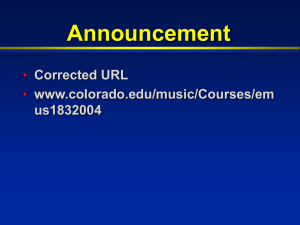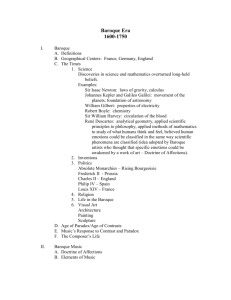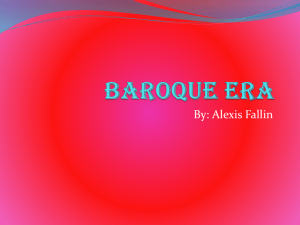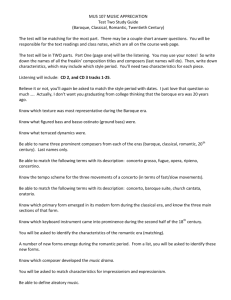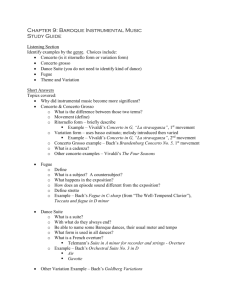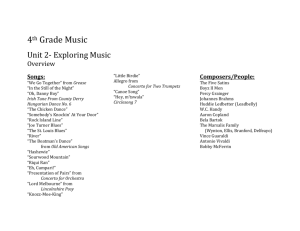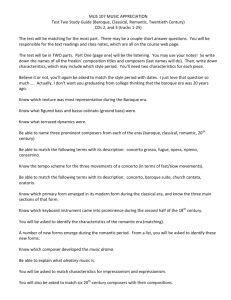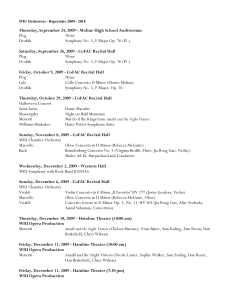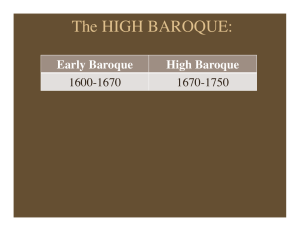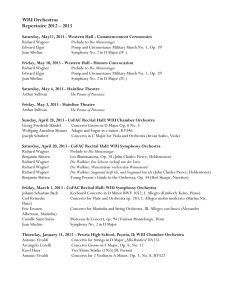“Spring” from The Four Seasons (1725) Antonio Vivaldi
advertisement
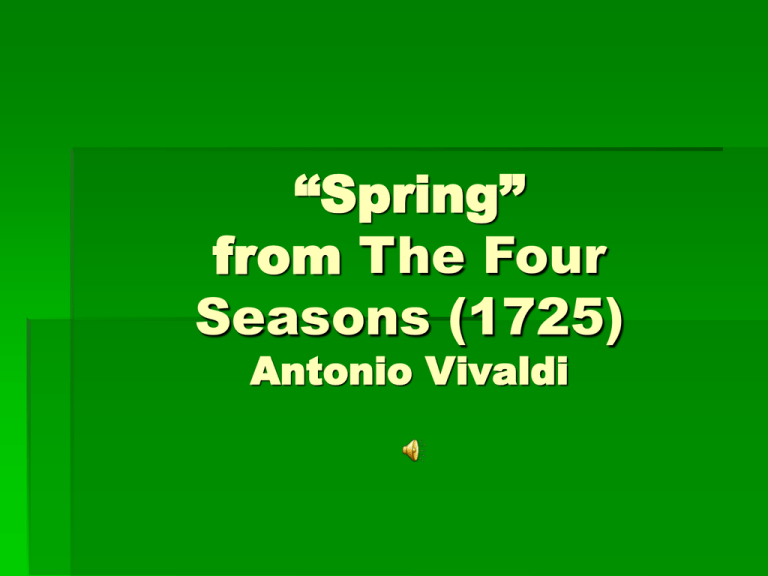
“Spring” from The Four Seasons (1725) Antonio Vivaldi The composition The violin concertos were first published in 1725 as part of a set of twelve concerti, Vivaldi's Op. 8, entitled Il cimento dell'armonia e dell'inventione (The Contest between Harmony and Invention). The first four concertos were designated Le quattro stagioni, each being named after a season. Each concerto is in three movements, with a slow movement between two faster ones. Concerto No. 1 in E major, Op. 8, "La primavera" (Spring) Allegro Largo Allegro Pastorale Concerto No. 2 in G minor, Op. 8, "L'estate" (Summer) Allegro non molto Adagio e piano – Presto e forte Presto Concerto No. 3 in F major, Op. 8, "L'autunno" also known as the "Danza Pastorale" (Autumn) Allegro Adagio molto Allegro Concerto No. 4 in F minor, Op. 8, "L'inverno" (Winter) Allegro non molto Largo Allegro Vivaldi's Four Seasons are among the boldest program music of the baroque period. Antonio Vivaldi wrote the individual Sonnets to go along with each movement of the Four Seasons. “Spring” sonnet text 1. Spring has come and joyfully the birds greet it with happy song, and the brooks, while the streams flow along with gentle murmur as the zephyrs blow. There come, shrouding the air with a black cloak, lighting and thunder chosen to herald [the storm]; then, when these are silent, the little birds return to their melodious incantations. 2. And now, in the pleasant, flowery meadow, to the soft murmur of leaves and plants, the goatherd sleeps with his faithful dog at his side. 3. To the festive sound of a pastoral bagpipe, nymphs and shepherds dance under their beloved roof, greeting the glittering arrival of the spring. Original orchestration: Solo violin, with string orchestra (violin, viola, cello, bass, harpsichord) An analysis of the first movement of Spring: “Allegro” http://youtu.be/kvEcOuJ1oV0 The composer: Antonio Lucio Vivaldi (4 March 1678 – 28 July 1741), nicknamed "The Red Priest" because of his red hair, was an Italian Baroque composer, priest, and virtuoso violinist, born in Venice. Vivaldi is recognized as one of the greatest Baroque composers, and his influence during his lifetime was widespread over Europe. Vivaldi is known mainly for composing instrumental concertos, especially for the violin, as well as sacred choral works and over 40 operas. The Four Seasons is his best-known work. Many of Vivaldi’s compositions were written for the female music ensemble of the Ospedale della Pietà, a home for abandoned children where Vivaldi worked from 1703 to 1715 and from 1723 to 1740. Vivaldi also had some success with stagings of his operas in Venice, Mantua and Vienna. After meeting the Emperor Charles VI, Vivaldi moved to Vienna hoping for preferment. The Emperor died soon after Vivaldi's arrival, and the composer died a pauper, without a steady source of income. The Time and Place The Baroque is a period of artistic style that used exaggerated motion and clear, easily interpreted detail to produce drama, tension, exuberance, and grandeur in sculpture, painting, architecture, literature, dance, and music. The style started around 1600 in Rome, Italy and spread to most of Europe. 1750, the year of J.S. Bach’s death, is usually listed as the end of the Baroque. Painting Paintings depicted images to evoke emotion. The portrait style of painting used light shadows to convey meaning and passion. Baroque artists chose to capture dramatic events that occurred over a period of time. Sculpture Human forms and figures constituted a major part of the Baroque culture. The demand for stone sculptures grew steadily during this era. The positioning of statues, interspersed with the use of sunlight and moonlight, were theatrically used in chapels. Marble carvings depicted human emotions on the faces of statues Architicture Music Virtuosity became recognized and instrumental soloists evolved Improvisation and ornamentation played an important role in performance The Opera developed during this period, as did the concerto. Major and minor tonalities evolved and meter became more consistent. Baroque clothing Venice San Marco Important events/discoveries 1600-1609 Playwright William Shakespeare of England writes Othello, King Lear and Antony and Cleopatra. 1610-1619 Pocahontas, daughter of the famed Indian chief of the Powhatans, marries John Rolfe after being held for ransom by the English colonists. 1620-1629 The Mayflower, carrying 100 pilgrims, arrives off the North American coast at Plymouth 1630-1639 Italian astronomer Galileo Galilei is threatened with torture if he refuses to withdraw his heretical propositions supporting a sun-centered solar system; Galileo recants. 1640-1649 Italian Evangelista Torricelli invents the first barometer, to measure air pressure. 1650-1659 Clockmaking is revolutionized when Dutch mathematician Christian Huygens introduces the use of the pendulum. 1660-1669 The production of world-renowned Stradivarius violins begins in Cremona, Italy 1670-1679 The famous Observatory in Greenwich, England, is founded for astronomical research; the observatory also establishes a standard time to help determine longitude. 1680-1689 English physicist Isaac Newton defines the laws of gravity and universal laws of motion. 1690-1699 he infamous witch trials of Salem begin in the colony of Massachusetts, and 20 "witches" are eventually put to death. 1700-1709 Edmund Halley's studies propose that comets sighted in 1531, 1607, and 1682 are one and the same, and the celestial body is named Halley's Comet in his honor. 1710-1719 Physicist Gabriel Daniel Fahrenheit invents a thermometer that uses mercury instead of alcohol. 1720-1729 Inoculation is tested in two smallpox epidemics (in London and Boston) and proved successful. 1730-1739 Benjamin Franklin founds the first circulating library in North America. 1740-1749 Scottish physician James Lind discovers that citrus fruit is the only effective cure for scurvy. Glossary Concerto: (1) the solo concerto for one soloist and orchestra, (2) the concerto grosso for two or more soloists and orchestra An Opus number refers to a number generally assigned by composers to an individual composition or set of compositions on publication, to help identify their works. Program music is a type of art music that attempts to musically render an extra-musical narrative. The narrative itself might be offered to the audience in the form of program notes, inviting imaginative correlations with the music. A ritornello (Italian; "little return") is a recurring passage in Baroque music for orchestra or chorus. The first or final movement of a solo concerto may be in "ritornello form", in which the ritornello is the opening theme, always played by tutti, which returns in whole or in part and in different keys throughout the movement. References http://classicalmusic.about.com/od/baroqueperiod/ss/four seasons.htm http://artsalive.ca/pdf/mus/tour2004/vivaldi2004_en.pdf http://www.baroquemusic.org/vivaldiseasons.html http://www.baroquemusic.org/bqxvivaldi.html http://www.allmusic.com/artist/antonio-vivaldi-q8090 http://www.classicalscore.com/timeline/baroque.html http://library.thinkquest.org/15413/history/history-bar.htm
